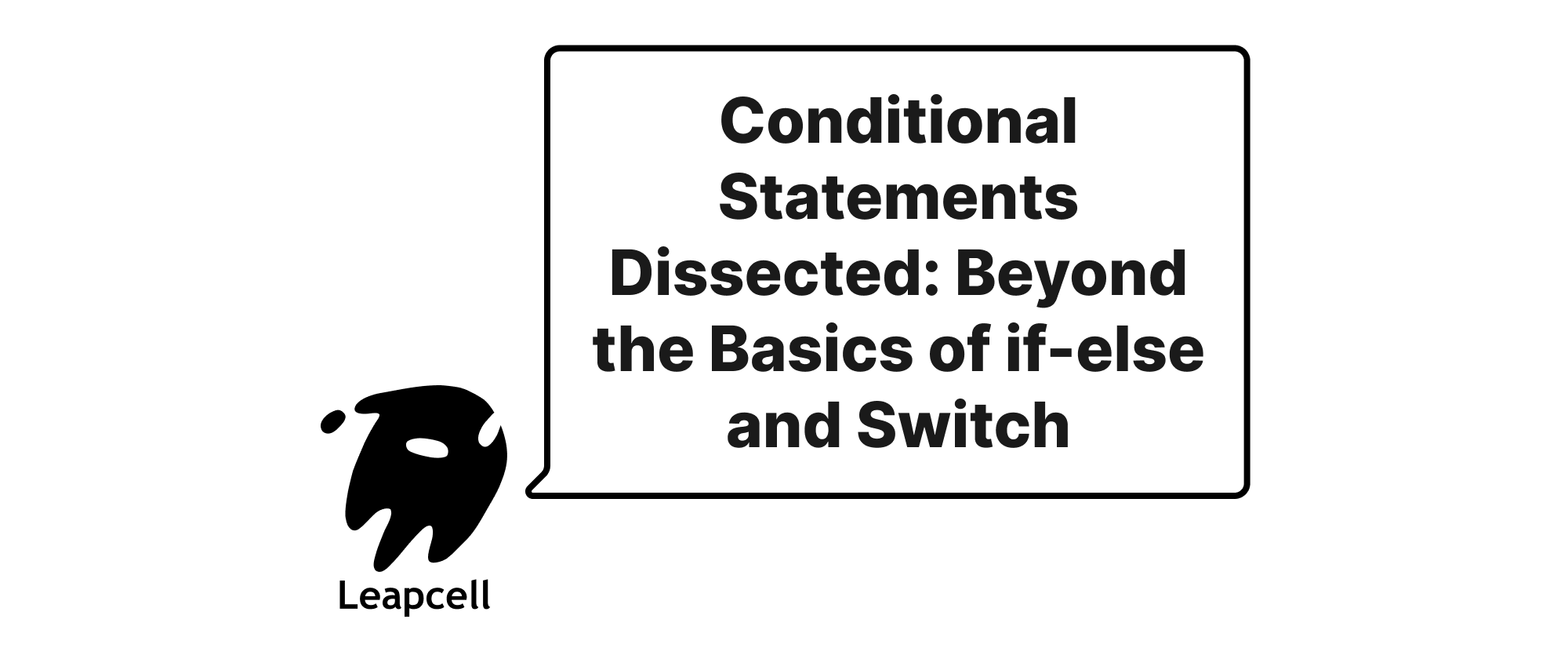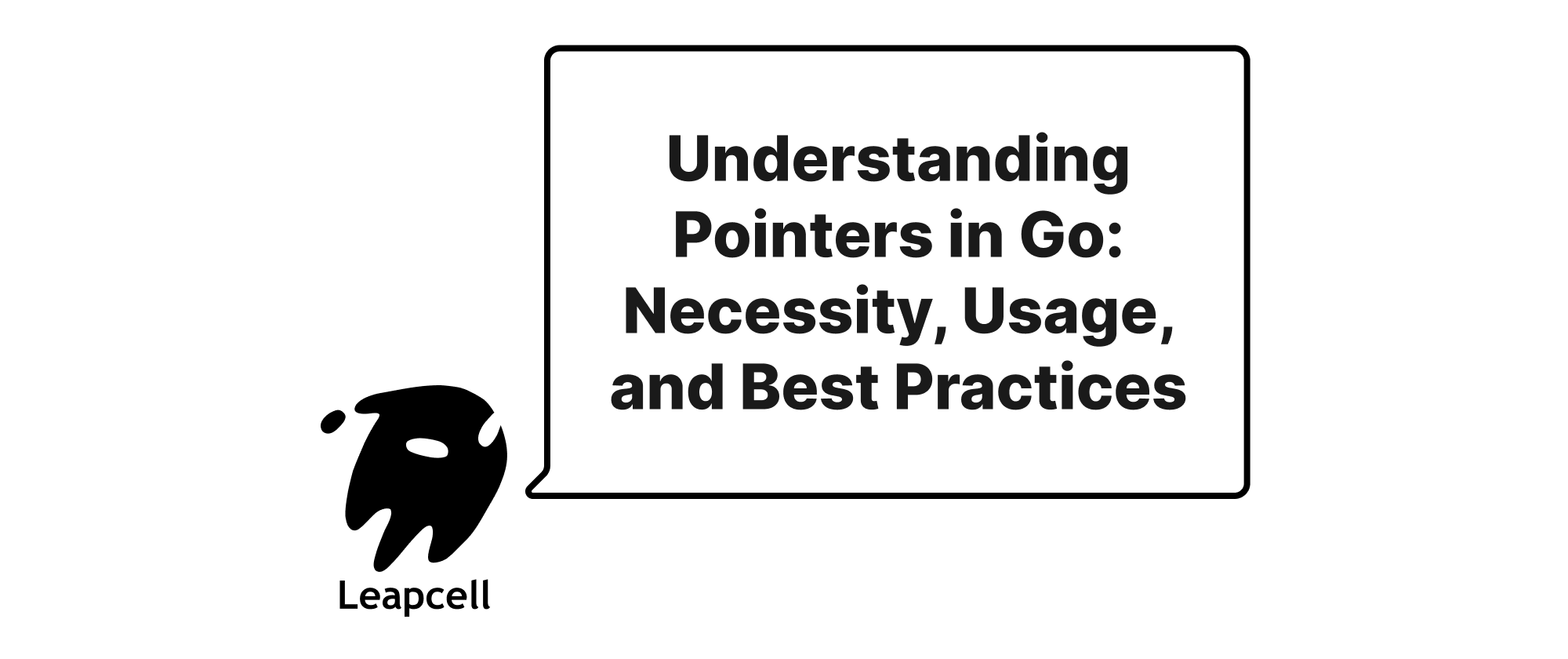Conditional Statements in Go: A Deep Dive into if-else and Advanced switch Usage
Min-jun Kim
Dev Intern · Leapcell

Conditional statements are fundamental building blocks in any programming language, allowing programs to make decisions and execute different blocks of code based on varying conditions. Go, with its pragmatic and clear syntax, provides if-else and switch statements to manage conditional logic effectively. While if-else offers straightforward branching, Go's switch statement is surprisingly powerful and versatile, often simplifying complex conditional logic that might otherwise require multiple if-else if blocks. This article will delve into both constructs, with a particular focus on the advanced capabilities of switch.
The if-else Construct: Straightforward Decision Making
The if-else statement in Go follows a familiar pattern from C-like languages, but with a Go-specific twist: the absence of parentheses around the condition.
The basic structure is:
if condition { // code to execute if condition is true } else { // code to execute if condition is false }
Go also supports else if for multiple conditions:
if condition1 { // code if condition1 is true } else if condition2 { // code if condition1 is false and condition2 is true } else { // code if neither condition1 nor condition2 is true }
A notable feature in Go's if statement is the optional short statement that can precede the condition. This allows for initializing variables that are local to the if and else blocks, promoting scope limitation and cleaner code.
Example: if-else with a Short Statement
Let's say we want to check if a user's score qualifies them for a certain rank. We can calculate the rank threshold within the if statement itself.
package main import "fmt" func main() { score := 75 if requiredScore := 70; score >= requiredScore { fmt.Printf("Congratulations! Your score of %d meets the required score of %d for Rank A.\n", score, requiredScore) } else { fmt.Printf("Keep trying! Your score of %d is below the required score of %d for Rank A.\n", score, requiredScore) } // `requiredScore` is not accessible here // fmt.Println(requiredScore) // This would cause a compile-time error }
This short statement is particularly useful for error handling with functions that return multiple values, commonly an optional result and an error.
package main import ( "fmt" "strconv" ) func main() { input := "123" if num, err := strconv.Atoi(input); err != nil { fmt.Printf("Error converting '%s': %v\n", input, err) } else { fmt.Printf("Successfully converted '%s' to integer: %d\n", input, num) } input = "abc" if num, err := strconv.Atoi(input); err != nil { fmt.Printf("Error converting '%s': %v\n", input, err) } else { fmt.Printf("Successfully converted '%s' to integer: %d\n", input, num) } }
This idiom for error checking is pervasive in Go programming and contributes to its reputation for clear error handling.
The switch Statement: Elegant Multi-way Branching
Go's switch statement is a powerful alternative to sequences of if-else if constructs, especially when dealing with multiple possible values for a single expression or even for more complex, non-constant conditions.
Basic switch Usage
The basic switch statement evaluates an expression and then executes the code block associated with the first case that matches the expression's value. Unlike many other languages, Go's switch automatically includes a break at the end of each case block, meaning execution does not "fall through" to the next case by default.
package main import "fmt" func main() { day := "Wednesday" switch day { case "Monday": fmt.Println("Start of the work week.") case "Friday": fmt.Println("Almost the weekend!") case "Saturday", "Sunday": // Multiple values in a single case fmt.Println("Weekend!") default: // Optional default case if no other case matches fmt.Println("Mid-week blues or other day.") } }
Advanced switch Capabilities
1. switch Without an Expression (Tagless switch)
One of the most versatile forms of switch is the "tagless switch," where no expression is provided after the switch keyword. In this mode, each case statement is treated as a boolean expression, and the first case that evaluates to true is executed. This is equivalent to an if-else if-else chain, but often more readable.
Example: Grade Calculation
package main import "fmt" func main() { score := 85 switch { // No expression here case score >= 90: fmt.Println("Grade: A") case score >= 80: fmt.Println("Grade: B") case score >= 70: fmt.Println("Grade: C") case score >= 60: fmt.Println("Grade: D") default: fmt.Println("Grade: F") } }
This tagless switch is incredibly powerful for complex conditional logic where different ranges or combinations of conditions determine the outcome.
2. switch with Short Statement
Similar to if, a switch statement can also include an optional short statement before its expression (or before the first case in a tagless switch). This helps localize variables.
Example: Check Length and Type of Input
package main import "fmt" func processInput(input string) { switch l := len(input); { // Short statement `l := len(input)` case l == 0: fmt.Println("Input is empty.") case l > 0 && l < 5: fmt.Printf("Input '%s' is short (length %d).\n", input, l) case l >= 5 && l < 10: fmt.Printf("Input '%s' is medium (length %d).\n", input, l) default: fmt.Printf("Input '%s' is long (length %d).\n", input, l) } } func main() { processInput("") processInput("Go") processInput("Golang") processInput("Programming") }
3. fallthrough Statement
While Go's switch implicitly breaks after each case, you can explicitly force execution to "fall through" to the next case using the fallthrough keyword. This is less common but can be useful in specific scenarios, for instance, when some actions overlap.
Important Note: fallthrough only transfers control to the immediately following case. It does not re-evaluate the condition of the next case.
Example: Service Level Calculation
Let's imagine a system where customer service levels are tiered. If a customer is Platinum, they also get the benefits of Gold and Silver.
package main import "fmt" func main() { customerTier := "Platinum" fmt.Printf("Customer Tier: %s\n", customerTier) fmt.Println("Benefits:") switch customerTier { case "Platinum": fmt.Println("- Dedicated account manager") fallthrough case "Gold": fmt.Println("- Priority support line") fallthrough case "Silver": fmt.Println("- Exclusive discounts") default: fmt.Println("- Standard support") } }
Output:
Customer Tier: Platinum
Benefits:
- Dedicated account manager
- Priority support line
- Exclusive discounts
If customerTier were "Gold", it would print "Priority support line" and "Exclusive discounts" but not "Dedicated account manager". This demonstrates how fallthrough provides fine-grained control over execution flow.
4. Type Switches (switch on types)
One of the most powerful and idiomatic uses of switch in Go is the "type switch." This allows you to check the concrete type of an interface value and execute different code based on that type. This is crucial for working with Go's interface{} (empty interface), which can hold values of any type.
The syntax for a type switch uses .(type):
switch variable.(type) { case Type1: // Code to execute if variable is of Type1 case Type2: // Code to execute if variable is of Type2 default: // Code if none of the above types match }
Within a case block of a type switch, you can declare a new variable (or reuse the existing one if it's named the same) that will have the concrete type asserted by that case.
Example: Processing Mixed Data Types
package main import "fmt" func processData(data interface{}) { switch v := data.(type) { // `v` will have the concrete type inside the case block case int: fmt.Printf("Received an integer: %d. Twice the value is %d.\n", v, v*2) case string: fmt.Printf("Received a string: '%s'. Length: %d.\n", v, len(v)) case bool: fmt.Printf("Received a boolean: %t.\n", v) case float64: fmt.Printf("Received a float: %.2f. Doubled: %.2f.\n", v, v*2) default: fmt.Printf("Received something else: %T (%v).\n", v, v) } } func main() { processData(10) processData("Hello, Go!") processData(true) processData(3.14159) processData([]int{1, 2, 3}) processData(nil) }
Output:
Received an integer: 10. Twice the value is 20.
Received a string: 'Hello, Go!'. Length: 11.
Received a boolean: true.
Received a float: 3.14. Doubled: 6.28.
Received something else: []int ([1 2 3]).
Received something else: <nil> (<nil>).
Type switches are incredibly useful for tasks like:
- Deserializing data from a universal format (e.g., JSON, XML) into specific Go types.
- Implementing polymorphic behavior for objects that don't share a common interface method (though interfaces are generally preferred for this).
- Handling events or messages that can be of various types.
Choosing Between if-else and switch
The choice between if-else and switch often comes down to readability and the nature of the conditions:
if-else: Preferif-elsefor two-way branching or when conditions are highly dependent on each other in a sequential manner, and perhaps involve complex boolean logic that doesn't fit neatly into specificcasevalues.switch(basic): Ideal when you have a single expression that you want to check against multiple discrete values. It's often cleaner and more concise than a longif-else ifchain for this purpose.switch(tagless): Excellent for handling multiple, non-mutually exclusive conditions, especially when dealing with ranges or more complex boolean expressions. It often reads more cleanly than a cascadingif-else ifblock.switch(type switch): The only way to dynamically determine and act upon the concrete type of an interface value. This is a unique and powerful Go idiom.
Conclusion
Go's conditional statements, if-else and switch, provide robust tools for controlling program flow. While if-else offers straightforward two-way branching and short-statement variable initialization, the switch statement in Go stands out for its flexibility. Its ability to act as a tagless multi-way conditional, its built-in break behavior, the explicit fallthrough, and especially its powerful type-switching capabilities, make it an incredibly versatile construct. Mastering these features will enable you to write more concise, readable, and idiomatic Go code.


